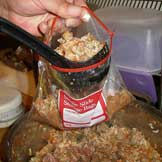
Controversy surrounds the inclusion of carbohydrates in cat food. Cats are carnivores after all, and as such, their natural diet is quite low in carbohydrates. They get some from the intestinal tracts of the animals they eat, but that’s about it.
There are certainly times when low/no carbohydrate foods are best – obesity and diabetes mellitus are two health conditions that immediately spring to mind. But when it comes to feeding healthy cats, the debate wears on. From a strictly practical point of view, I have to say that I’ve known some cats who have eaten nothing but high carbohydrate, dry food and have thrived into advanced old age, and others who obviously did better on low carbohydrate, canned foods. As is true with most things in life, I doubt the answer to the carb question will turn out to be one-size-fits-all.
No matter where your opinion falls on the carb — no carb continuum, there’s one thing that we can all agree on. It is often hard to determine just how many carbohydrates a cat food contains. Labeling regulations do not mandate that a carbohydrate percentage be listed, but you can figure it out yourself if you’re up to a bit of math.
Pet food labels must list the minimum crude protein percentage, minimum crude fat percentage, maximum crude fiber percentage, and maximum moisture percentage. They will also sometimes include a maximum value for ash. If this is not present, I use an estimate of 3% for canned foods and 6% for dry. Once you add up protein, fat, fiber, moisture, and ash, the only thing left is carbohydrate.
I just grabbed a can of my cat’s food and this is what the guaranteed analysis says:
Crude Protein (min): 12%
Crude Fat (min): 2.0%
Crude Fiber (max): 1.5%
Moisture (max): 80%
Ash (max): 3%
Therefore, this food’s carb content is 100 – (12 + 2 + 1.5 + 80 + 3) = 1.5%
Now, these answers aren’t going to be exact because we are dealing with minimums and maximums and sometimes an estimate for ash, but it’ll get you into the ballpark. (When I did this with another can of food that I know has no carbs, my result was -2.)
In comparison, my cat’s dry food guaranteed analysis looks like this:
Crude Protein (min): 38%
Crude Fat (min): 8.5%
Crude Fiber (max): 4.3%
Moisture (max): 12%
Ash (max): 6%
To calculate the carb content: 100 – (38 + 8.5 + 4.3 + 12 + 6) = 31.2%
Now both of these products report their guaranteed analyses on an “as fed” basis, meaning that comparing dry and canned foods is almost impossible due to their wildly different moisture contents. To correct for this we need to convert our result into a “dry matter” basis. Here’s how:
Find the percent moisture and subtract that number from 100. This is the percent dry matter for the food. Next divide the nutrient percentage on the label that you are interested in by the percent dry matter for the food and multiply by 100. The resulting number is the nutrient percentage on a dry matter basis.
For example, the dry food label lists its moisture content at 12% and we calculated percent carbohydrate to be 31.2%. To figure out the food’s carb level on a dry matter basis, the calculations in this case would be 100-12=88 and then 31.2/88 x 100 = 35.4%. The canned food’s calculations look like 100-80 = 20, 1.5/20 x 100 = 7.5.
So at least now you know how to figure out how many carbs are in your cat’s food, even if the definitive answer to how many should be there remains elusive.

Dr. Jennifer Coates
Image: Thinkstock









